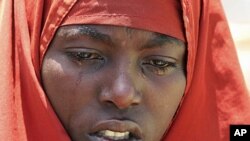The United Nations reports that famine in southern Somalia has subsided in three regions, due in part to the success of humanitarian intervention. Despite the improvement, the U.N. warns that nearly 250,000 people are still at risk of starvation.
The U.N. Food Security and Nutrition Analysis Unit (FSNAU) and a U.S. famine warning network known as FEWS NET have confirmed that a famine no longer exists in the areas of Bay, Bakool and Lower Shabelle.
The agencies say humanitarian assistance helped improve access to food in the regions and to bring down rates of death from malnutrition.
However, famine conditions still persist in three other regions - in Middle Shabelle, Afgooye and among the population of displaced people living in Mogadishu.
Famine is a technical term, indicating a certain statistical level of food deficit, malnutrition and death.
Aid agencies working in the area are cautioning that, just because the famine has technically subsided, this does not mean people are not still in need of urgent assistance.
Louis Belanger is a spokesperson for Oxfam, an aid organization working in southern Somalia. “It doesn't mean that we need to scale back. It doesn't mean that the work doesn't continue. On the opposite, I think there's still a huge amount of people that still need basic assistance: water, shelter, medicine and, of course, food. So, for us, the work continues and we're looking to scale up our programs all across southern Somalia where we work with local partners,” he said.
Belanger says the Kenyan military offensive in southern Somalia also is threatening aid work and putting vulnerable people further out of reach.
“Unfortunately the recent offensive and the recent conflict has slowed us down a little bit, and we've had to delay or stop our programs that would reach around 85,000 people. So that's rather worrying," Belanger explained. "We hope that the focus of the international community will be on helping the people of Somalia, [to] make sure that they receive good quality assistance in a timely way.”
Kenyan troops entered Somalia about a month ago in pursuit of al-Shabab militants blamed for a series of cross-border kidnappings.
The U.N. and U.S. famine monitoring agencies say the famine is likely to subside in other regions of Somalia by the end of the year.
But they warn that four million people will still need emergency assistance for the next nine months. Death rates are also expected to remain high, particularly for young children, due to a continuing risk of outbreaks cholera, measles and other diseases.
An exact death toll is unknown, but the U.N. says tens of thousands of people have died in Somalia since April.
Famine Subsides in Somalia, Starvation Risk Remains













